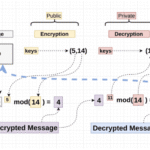In the realm of cryptography, one principle stands majestically above the rest: Kerckhoff’s Principle. This adage, posited by Auguste Kerckhoffs in the 19th century, asserts that a cryptographic system should remain secure even if everything about the system, except for the key, is public knowledge. This essay delves into the essence of this principle, exploring its implications, underlying rationale, and its enduring significance in contemporary cryptography.
Kerckhoff’s Principle resonates with a fundamental truth in security practices—that secrecy of the algorithm should not be relied upon. Instead, the security of a cipher must hinge upon the secrecy of the key. This philosophy introduces a paradigm shift in the way cryptographic systems are designed and evaluated. Security through obscurity, which presumes that keeping the method hidden guarantees safety, is an inherently flawed approach. Not only does this methodology create an overreliance on secrecy, but it also ultimately leads to a façade of security.
The historical context of the principle provides clarity on its relevance. In the 19th century, cryptographers were often concerned with concealing the details of their ciphers. Kerckhoffs elaborated on the futility of this strategy by highlighting potential adversaries. If an enemy were to gain access to the algorithm, the system’s underlying security could be compromised. By emphasizing that the enemy might know the system’s functioning, Kerckhoffs pointed toward a critical insight: the necessity of robustness in a cipher’s design.
The implications of Kerckhoff’s Principle extend beyond theoretical musings into practical applications. For instance, modern encryption standards such as the Advanced Encryption Standard (AES) uphold this principle vigorously. The algorithms behind AES are openly published, scrutinized, and analyzed by cryptographers worldwide. However, as long as the key itself remains secret, the encryption retains its integrity. This communal vetting process of the algorithm enhances trust and security, epitomizing a collaborative approach to cryptographic resilience.
Diving deeper into the psychology of security reveals why many practitioners and theorists abide by Kerckhoff’s guidelines. It creates a level of comfort among users, knowing that even if malicious agents are privy to the encryption algorithm, they are left impotent without the key. This dynamic brings forth a paradigm wherein the onus of security shifts from the complexity of the algorithm to the strength of the key management practices. Such a shift encourages the adoption of better key generation, handling, and storage techniques, which are fundamental to any robust security architecture.
Moreover, Kerckhoff’s Principle has broader implications beyond just cryptographic systems. In software engineering and information security strategies, the reliance on hidden details often leads to vulnerabilities. The transparent design philosophy advocated by Kerckhoffs encourages the development of systems that remain secure against adversarial attempts, even when their architecture is known. This is particularly pertinent in the age of open-source software, where collaboration and peer review serve as deterrents against weaknesses within codebases.
In exploring the foundational ideas behind Kerckhoff’s Principle, we encounter the notion of adversarial capability. A sophisticated attacker is likely to employ various techniques—reverse engineering, cryptanalysis, or even social engineering—to compromise a system. In this context, relying on an obscure algorithm can foster a false sense of security, potentially resulting in cataclysmic failures when breaches occur. Kerckhoff’s Principle assumes that attackers will utilize all possible means available to decipher or exploit weaknesses, thereby reinforcing a need for vigilance and resilience in security practices.
Looking towards contemporary advancements, quantum computing and its potential to break classical ciphers ignites discussions regarding the future applicability of Kerckhoff’s Principle. The looming threat posed by quantum algorithms necessitates the evolution of encryption standards to ensure resilience even with the possibility of formidable computational power. This movement towards post-quantum cryptography aligns with Kerckhoff’s ethos where the algorithm can remain public, yet must withstand the challenges posed by quantum adversaries.
Furthermore, the principle invites a philosophical inquiry into the nature of trust and security in an interconnected world. Cryptographic principles are not merely technical specifications; they can be viewed through the lens of societal norms. Trust remains a cornerstone of communication, commerce, and personal interactions in the digital age. Kerckhoff’s ideas serve as a reminder that, akin to social contracts, cryptographic architectures must be founded on transparency, mutual understanding, and collective engagement regarding security—where everyone bears a component of responsibility.
In conclusion, Kerckhoff’s Principle encapsulates the essence of secure cryptographic design, emphasizing the critical nature of the key’s secrecy while embracing algorithmic transparency. This paradigm has proved its worth across centuries, urging cryptographers and security practitioners to focus on robust processes rather than the illusory safety of secretive mechanisms. As we march toward an increasingly digital future, infused with challenges posed by emerging technologies, the enduring wisdom of Kerckhoff’s Principle will undoubtedly steer the evolution of secure communication practices, fostering an environment where vulnerability is diminished and resilience is tenacious.







Leave a Comment